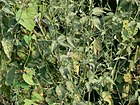Note: This is a project under development. The articles on this wiki are just being initiated and broadly incomplete. You can Help creating new pages.
Difference between revisions of "Peristrophe bicalyculata - Kākajaṅgha"
(→Chemical Composition) |
|||
| Line 8: | Line 8: | ||
==Chemical Composition== | ==Chemical Composition== | ||
| − | + | Bicalyculata, Beta-caryophyllene (33.9%), Alpha-zingiberene (10.4%), Germacrene D and globulol (5.0%) were the compounds occurring in abundance. The oil of B. verticillata had an abundance of phytol (56.3%) and 1, 8-cineole (20.4%), with sizeable proportions of alpha-pinene (7.1%) and p-cymene (4.0%). | |
<ref name="chemical composition"/> | <ref name="chemical composition"/> | ||
Revision as of 17:37, 11 June 2020
Kākajaṅgha consists of dried mature seed of Peristrophe bicalyculata (Retz.) Nees (Fam. Acanthaceae), an erect hispid herb 60 to 180 cm tall, found in forests and waste lands almost throughout the country.
Contents
- 1 Uses
- 2 Parts Used
- 3 Chemical Composition
- 4 Common names
- 5 Properties
- 6 Habit
- 7 Identification
- 8 List of Ayurvedic medicine in which the herb is used
- 9 Where to get the saplings
- 10 Mode of Propagation
- 11 How to plant/cultivate
- 12 Commonly seen growing in areas
- 13 Photo Gallery
- 14 References
- 15 External Links
Uses
Snake bites, Fractures, Sprain, Fever, Cold and cough, Skin disorders [1]
Parts Used
Chemical Composition
Bicalyculata, Beta-caryophyllene (33.9%), Alpha-zingiberene (10.4%), Germacrene D and globulol (5.0%) were the compounds occurring in abundance. The oil of B. verticillata had an abundance of phytol (56.3%) and 1, 8-cineole (20.4%), with sizeable proportions of alpha-pinene (7.1%) and p-cymene (4.0%). [2]
Common names
| Language | Common name |
|---|---|
| Kannada | Cibigid, Cibirsoppu |
| Hindi | Atrilal, Masi, Kaakjanghaa |
| Malayalam | Raankiraayat |
| Tamil | Chebira |
| Telugu | Chebira |
| Marathi | NA |
| Gujarathi | NA |
| Punjabi | NA |
| Kashmiri | NA |
| Sanskrit | Kākatiktā, Prācībala, Sulomaṣā, Vāyasajaṇghā |
| English |
Properties
Reference: Dravya - Substance, Rasa - Taste, Guna - Qualities, Veerya - Potency, Vipaka - Post-digesion effect, Karma - Pharmacological activity, Prabhava - Therepeutics.
Dravya
Rasa
Tikta, Kaṣāya
Guna
Sara, Picchila
Veerya
Uṣṇa
Vipaka
Kaṭu
Karma
Kaphapittanut, Kṛmighna, Varṇya, Vraṇahara, Viḍaghna
Prabhava
Habit
Identification
Leaf
| Kind | Shape | Feature |
|---|---|---|
| Ovate | acuminate | rounded at base, sometims narrowed, more or less hairy on both sides |
Flower
| Type | Size | Color and composition | Stamen | More information |
|---|---|---|---|---|
| linear-spathulate | 2-4cm long | pink | Bracteoles 4, similar to the bracts but shorter |
Fruit
| Type | Size | Mass | Appearance | Seeds | More information |
|---|---|---|---|---|---|
| Capsules pubescent | pointed | Seeds 2-3 minutely glandular papillose | 4-seeded | Fruiting throughout September - January |
Other features
List of Ayurvedic medicine in which the herb is used
Where to get the saplings
Mode of Propagation
How to plant/cultivate
Commonly seen growing in areas
Photo Gallery
References
- ↑ "uses"
- ↑ Chemical composition
- ↑ "Morphology"
- ↑ [ "Cultivation detail"]
External Links
- Ayurvedic Herbs known to be helpful to treat Snake bites
- Ayurvedic Herbs known to be helpful to treat Fractures
- Ayurvedic Herbs known to be helpful to treat Sprain
- Ayurvedic Herbs known to be helpful to treat Fever
- Ayurvedic Herbs known to be helpful to treat Cold and cough
- Ayurvedic Herbs known to be helpful to treat Skin disorders
- Herbs with Whole plant used in medicine
- Herbs with common name in Kannada
- Herbs with common name in Hindi
- Herbs with common name in Malayalam
- Herbs with common name in Tamil
- Herbs with common name in Telugu
- Herbs with common name in Sanskrit
- Habit - Herb
- Index of Plants which can be propagated by Seeds
- Index of Plants which can be propagated by Cuttings
- Herbs that are commonly seen in the region of Deciduous forest
- Herbs
- Acanthaceae



